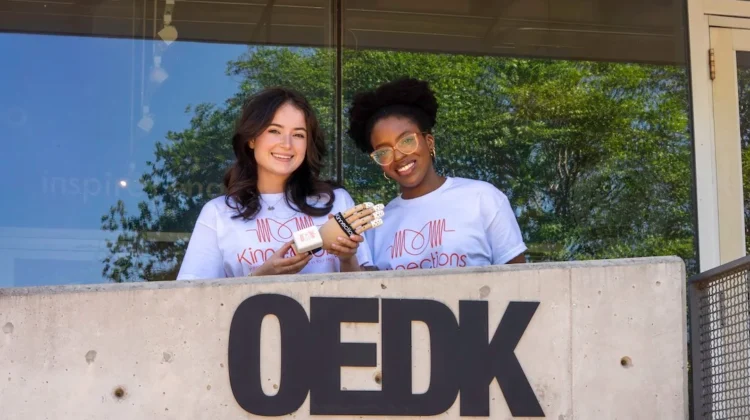
Two engineering students at Rice University in Houston have designed an affordable, wearable solution for reducing the symptoms of Parkinson’s disease.
The design of the vibrotactile glove created by undergraduate engineering students Emmie Casey (pictured above, at left) and Tomi Kuye (pictured above, at right), under the guidance of Maria Oden and Heather Bisesti, and with support from the Oshman Engineering Design Kitchen (OEDK), is based on promising research caried out by the Peter Tass lab at Stanford University, which explores how randomised vibratory stimuli delivered to the fingertips could help rewire misfiring neurons in the brain – a hallmark of Parkinson’s disease.
The Stanford team’s clinical trials showed that coordinated reset stimulation via vibrations helped patients regain motor control and reduce abnormal brain activity. Remarkably, these effects lasted after users removed the gloves and no longer experienced the stimulation in their fingertips.
Casey and Kuye saw an opportunity to harness this research and develop a low-cost version of the gloves that Stanford was creating, making improvements to the design along the way.
‘We wanted to take this breakthrough and make it accessible to people who would never be able to afford an expensive medical device,’ Casey said. ‘We set out to design a glove that delivers the same therapeutic vibrations but at a fraction of the cost.’
Their prototype replaces the costly motors used in other designs with the same tiny vibration motors found in smartphones. These are embedded into each fingertip of a soft, wireless glove and driven by a custom-designed printed circuit board located at the wrist.
While many of the existing glove designs for Parkinson’s focus on stabilising tremors with weights or rigid structures, the Rice team’s solution goes deeper by targeting the root of the neurological disruption.
‘This glove is designed to stimulate the Pacinian corpuscles within the fingertips to help resynchronise the neurons within the brain that cause tremors and stiffness,’ Kuye said. ‘We’re not just masking symptoms. We’re aiming to actually retrain this part of the brain.’
The students’ commitment to accessibility goes beyond engineering. In addition to developing a commercial version priced at about US$250, they’ve also published open-source instructions online for anyone who wants to build their own glove at home. The team has received interest from more than 200 individuals around the world, many of whom lack the technical expertise to assemble the device themselves. In response, Casey and Kuye have formed a non-profit and are using a sliding scale price model to ensure cost is never a barrier. They are also taking pre-orders on their website and accepting donations with the hope of releasing the first 500 pairs by this autumn.

Meanwhile, Casey and Kuye are working to secure Institutional Review Board approval to evaluate the usability of the device, and they say they hope to collaborate with partners in the Texas Medical Center to evaluate the device’s effectiveness with patients.
‘This project exemplifies what we strive for at the OEDK – empowering students to translate cutting-edge research into real-world solutions,’ said Oden, teaching professor of bioengineering, director of the OEDK and co-director of the Rice 360 Institute for Global Health Technologies. ‘Emmie and Tomi have shown extraordinary initiative and empathy in developing a device that could bring meaningful relief to people living with Parkinson’s, no matter their resources.’
Initial anecdotal feedback has been promising. One early prototype, built for a friend’s mother who has early onset Parkinson’s, yielded surprising results.
‘After about six months of wearing the gloves regularly, she was able to walk unaided,’ Casey said, adding that their current recommendation is for users to wear the glove for about two hours twice a day to maximise benefit.
‘We’re not claiming it’s a cure,’ Kuye said. ‘But if it can give people just a little more control, a little more freedom, that’s life changing.’


